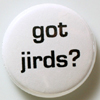

|
|||||
|
Home Shaw's Jird Links Natural
History Captive
Husbandry To recommend a link please send an email. Shaw's Jird Breeders To recommend a breeder please send an email. |
Shaw's
Jird Article By Russel Tofts Jirds are becoming increasingly popular as pets, being fairly large, easy to handle, extremely reluctant to bite, and much slower than the perennially popular Mongolian Gerbil (Meriones unguiculatus), to which they are closely related. The reason they are not more frequently available within the UK. is, I think, that unlike the Mongolian Gerbil, they have a reputation for being difficult to breed, and indeed I had maintained the species - on and off - for several years before I finally achieved success. Even now I estimate that approximately half of the neonates born fail to survive to maturity. I suspect that the parents are very sensitive to disturbance at this delicate time. In the wild, Shaw’s Jirds are found in North Africa, from Morocco to Egypt. Until very recently I kept a breeding trio (one male, 2 females). Another report on the Internet stresses that female Jirds cannot be kept together as they will fight. I dispute this as my females have never shown any aggression towards each other (or, indeed, to the male), although this may be because all three are related. I NEVER remove the male after the babies are born because I believe his presence can have a calming influence and some will even help in rearing the babies; he will never intentionally harm his new-born offspring. My breeding male ("Honey"-) was born on 14th October 1997. There were 5 in the litter (2 males and three females). All five arrived at Pet-Paks on 30th November of that year, of which one pair was subsequently resold on 28th December. He sired his first litter in February 1998. Nine babies were born (and successfully reared). This seems to be an unusually large litter, and I tend to think that both females gave birth simultaneously. Since then, 8 more litters have been produced (one litter only very recently). The relatively high mortality rate among the babies is of some concern, but I feel it is stress related. Cage maintenance should be kept to a minimum after the young are born. "Honey" has proved himself to be an exemplary father. He has always remained with his new-born babies and has never been seen to interfere with them or harm them in any way. Curiously, neither does the other female seem to mind the presence of babies not her own. Although "Honey" was breeding very successfully, it was felt undesirable in the long term to allow him to continue to do so with such closely related females, and so he was removed from them on 6th January 1999 and introduced to a young unrelated female ("Nut"). Jirds and other gerbils are very territorial and it can be difficult to mix unrelated animals, but in "Honey" and "Nut’s" case, there was no problem and the two animals have settled down very well together. I am hoping that he will breed as successfully with his new partner as he has done with his previous two mates. Already, two babies have been born, although regrettably they did not survive (the female may be too young and inexperienced), but it augers well for the future. About The Author In 1997 I was appointed manager of the small animal department in a major pet superstore, with carte blanche over new developments within the department, a position I held for nearly three years during which time it boasted the largest and most comprehensive collection of small mammals to be found in any British pet shop. The following year I realised a lifelong ambition by seeing animals in their natural habitat in Africa, the subject of my first book, "Kenkay and Colobus - a tourist in ghana".. I am an active member of various zoological and conservation organisations including the Rodent & Lagomorph Taxon Advisory Group (TAG), the EEP for the Edward's Pheasant, Independent Zoo Enthusiasts' Society, National Association of Private Animal Keepers (NAPAK), and the Association of British Wild Animal Keepers (ABWAK). I have contributed articles to a variety of magazines, including the International Zoo News, and have appeared on television and radio. in 1999 I launched the Rodent Appreciation Group, for anyone interested in the Order Rodentia, particularly the rarer or more unusual species.
|
 Click to join EFExotics  Pins and magnets in the store! Shaw's
Jird
Images
To submit genet images please send an email.
|
|||